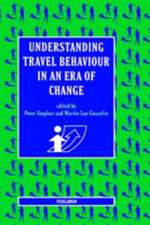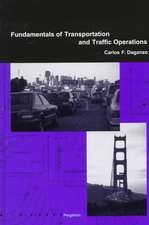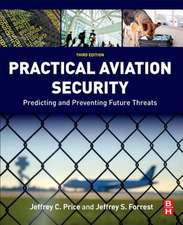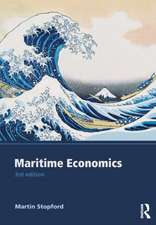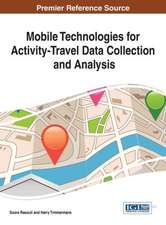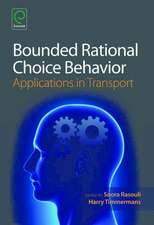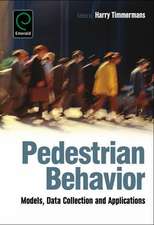Progress in Activity–Based Analysis
Autor Harry Timmermansen Limba Engleză Hardback – 13 iul 2005
This volume reflects an eventful decade of development and application of activity-based models. In three extensive sections, it:
-reviews a range of approaches to incorporating increased complexity in models;
-discusses how to obtain the rich data necessary to support complex models;
-and reports on real applications in action.
Essential reading for any researcher or practitioner wishing to keep abreast of this key area of transportation research.
Preț: 1128.46 lei
Preț vechi: 1465.53 lei
-23% Nou
Puncte Express: 1693
Preț estimativ în valută:
215.96€ • 234.50$ • 181.40£
215.96€ • 234.50$ • 181.40£
Carte tipărită la comandă
Livrare economică 22 aprilie-06 mai
Preluare comenzi: 021 569.72.76
Specificații
ISBN-13: 9780080445816
ISBN-10: 0080445810
Pagini: 528
Dimensiuni: 155 x 234 x 711 mm
Greutate: 0.88 kg
Ediția:New.
Editura: Emerald Publishing
ISBN-10: 0080445810
Pagini: 528
Dimensiuni: 155 x 234 x 711 mm
Greutate: 0.88 kg
Ediția:New.
Editura: Emerald Publishing
Public țintă
This book will be of interest to academic researchers, and also to higher level practitioners from the various branches of the transport profession (transport planners, traffic engineers, public transport managers, routers and schedulers for public transport or freight, logisticians, and many more) as well as transport geographers.Cuprins
Activity-Based Approaches: Models, Data and Applications. (H. Timmermans). Contributions to Understanding Joint Relationships among Activity and Travel Variables. (R.M. Pendyala, Xin Ye). A Dynamic Programming Approach for the Activity Generation and Scheduling Problem (A. Karlström). Simulation of Daily Activity Patterns. (O. Pribyl, K.G. Goulias). Simulation Daily Activity Patterns through the Identification of Sequential Dependencies. (D. Janssens et al.). Adjustments of Activity Timing and Duration in an Agent-Based Traffic Flow Simulation. (M. Balmer, B. Raney, K. Nagel). The Scheduling Agent -Using Sesam to Implement a Generator of Activity Programs. (G. Rindsfüser, F. Klügl). Activity-Based Analysis of Travel Demand Using Cognitive Agents. (R.J. F. Rossetti, R. Liu). Adaptation of Time Use Patterns to Simulated Travel Times in a Travel Demand Model. (G. Hertkorn, P. Wagner). An Integrated Framework for Modelling Short- and Long-Run Household Decision-Making. (E. Miller). Strategies for Resolving Activity Scheduling Conflicts: An Empirical Analysis. (M. Roorda, E. Miller). Sequential and Simultaneous Choice Structures for Modelling Intra-Household Interactions in Regional Travel Models. (P. Vovsha et al.). An Empirical Comparison of Alternative Models of Household Time Allocation. (Junyi Zhang et al). Incorporating Latent Determinants in Activity Time Allocation Modelling: Application to Value of Activity Time Estimation. (K.P. Nepal, D. Fukuda, T. Yai). An Analysis of Activity Type Classification and Issues Related to the With Whom
and For Whom Questions of an Activity Diary. (K.G. Goulias, Tae-Gyu Kim). Recent Developments in Activity Diary-Based Surveys and Analysis: Some Japanese Case Studies. (Kazuo Nishii et al.). A Data Collection Strategy for Perceived and Observed Flexibility in the Spatio-Temporal Organisation of Household Activities and Associated Travel. (M.E.H. Lee-Gosselin). The Design and Implementation of an Activity Scheduling Survey Using The Internet
(T.Ruiz). Activity-Based Travel Forecasting Models in The United States: Progress Since 1995
and Prospects for the Future. (P. Vovsha, M. Bradley, J.L. Bowman). Two Applications of GIS-Based Activity-Travel Simulators.
(Nobuaki Ohmori, Noboru Harata, Katsutoshi Ohta). The Relation Between Motives and Frequency of Telework: A Qualitative Study from The Oslo Region on Telework and Transport Effects. (R.J. Hjorthol). Changing Travel Characteristics and Activity Travel Patterns of Households Through Telecommuting?
(A. Glogger, T. Zängler, G. Karg). Communication and Travel Behaviour: Two Facets of Human Activity Patterns. (C. Nobis, B. Lenz, C. Vance). Choices of Activity- and Travel-Change Options for Reduced Car Use. (P. Loukopoulos et al.).
and For Whom Questions of an Activity Diary. (K.G. Goulias, Tae-Gyu Kim). Recent Developments in Activity Diary-Based Surveys and Analysis: Some Japanese Case Studies. (Kazuo Nishii et al.). A Data Collection Strategy for Perceived and Observed Flexibility in the Spatio-Temporal Organisation of Household Activities and Associated Travel. (M.E.H. Lee-Gosselin). The Design and Implementation of an Activity Scheduling Survey Using The Internet
(T.Ruiz). Activity-Based Travel Forecasting Models in The United States: Progress Since 1995
and Prospects for the Future. (P. Vovsha, M. Bradley, J.L. Bowman). Two Applications of GIS-Based Activity-Travel Simulators.
(Nobuaki Ohmori, Noboru Harata, Katsutoshi Ohta). The Relation Between Motives and Frequency of Telework: A Qualitative Study from The Oslo Region on Telework and Transport Effects. (R.J. Hjorthol). Changing Travel Characteristics and Activity Travel Patterns of Households Through Telecommuting?
(A. Glogger, T. Zängler, G. Karg). Communication and Travel Behaviour: Two Facets of Human Activity Patterns. (C. Nobis, B. Lenz, C. Vance). Choices of Activity- and Travel-Change Options for Reduced Car Use. (P. Loukopoulos et al.).


